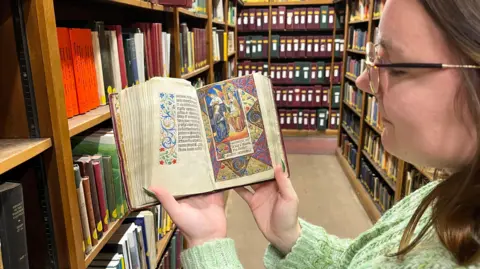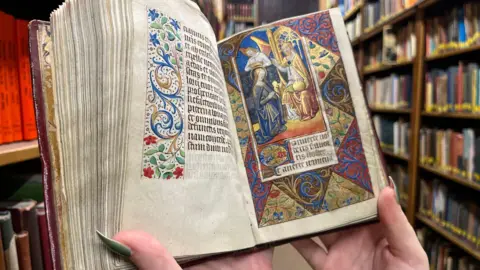Medieval monthly guide on display for new year
 Leeds City Council
Leeds City CouncilA 540-year-old manuscript sharing duties to be carried out each month for the year ahead is set to go on display.
Written in about 1480, the Horae Beatae Mariae Virginis, or Book of Hours, depicts signs of the zodiac and was designed to help individuals keep up with a rigorous schedule of tasks and prayers at home.
It contains 46 vivid images and is written on vellum, with the title going on display at Leeds Central Library from Tuesday.
Rhian Isaac, the library's special collections librarian, said it was one of the most beautiful books in the entire collection.
"The colours and intricate details are still vivid after hundreds of years of reading," she said.
"While our priorities and how we structure our lives may have changed, it's interesting to reflect on how people in the medieval period looked to develop their own routines and organise their daily lives."
Devotional books first became popular in the 13th Century among wealthier classes, the library said.
They would have been very expensive and beyond the reach of most people at the time.
According to the library, the Book of Hours manuscript was most likely produced in Paris in around 1480, possibly by a family-run businesses.
It was donated to the library in 1929 by Beryl Gott, who also gave a collection of gardening books and periodicals.
 Leeds City Council
Leeds City CouncilThe book would have been used by lay people to practice their faith in their homes.
It contains pictures for each month illustrating the typical work that required doing at that time of year.
"The picture for January has a gentleman sitting at a long table with a goblet of probably wine in front of him - he's definitely feasting of sorts," library officer Philip Wilde said.
"In April they're planting seeds and May they're going hawking."
He continued: "Harvesting would come up in July and August, and in November and December you were preparing for Christmas again."
The Books of Hours also contains computational tables allowing the reader to calculate when Easter Sunday was going to be.
It will go on display alongside a selection of calendars and almanacs from the library's collection.
Listen to highlights from West Yorkshire on BBC Sounds, catch up with the latest episode of Look North or tell us a story you think we should be covering here.
